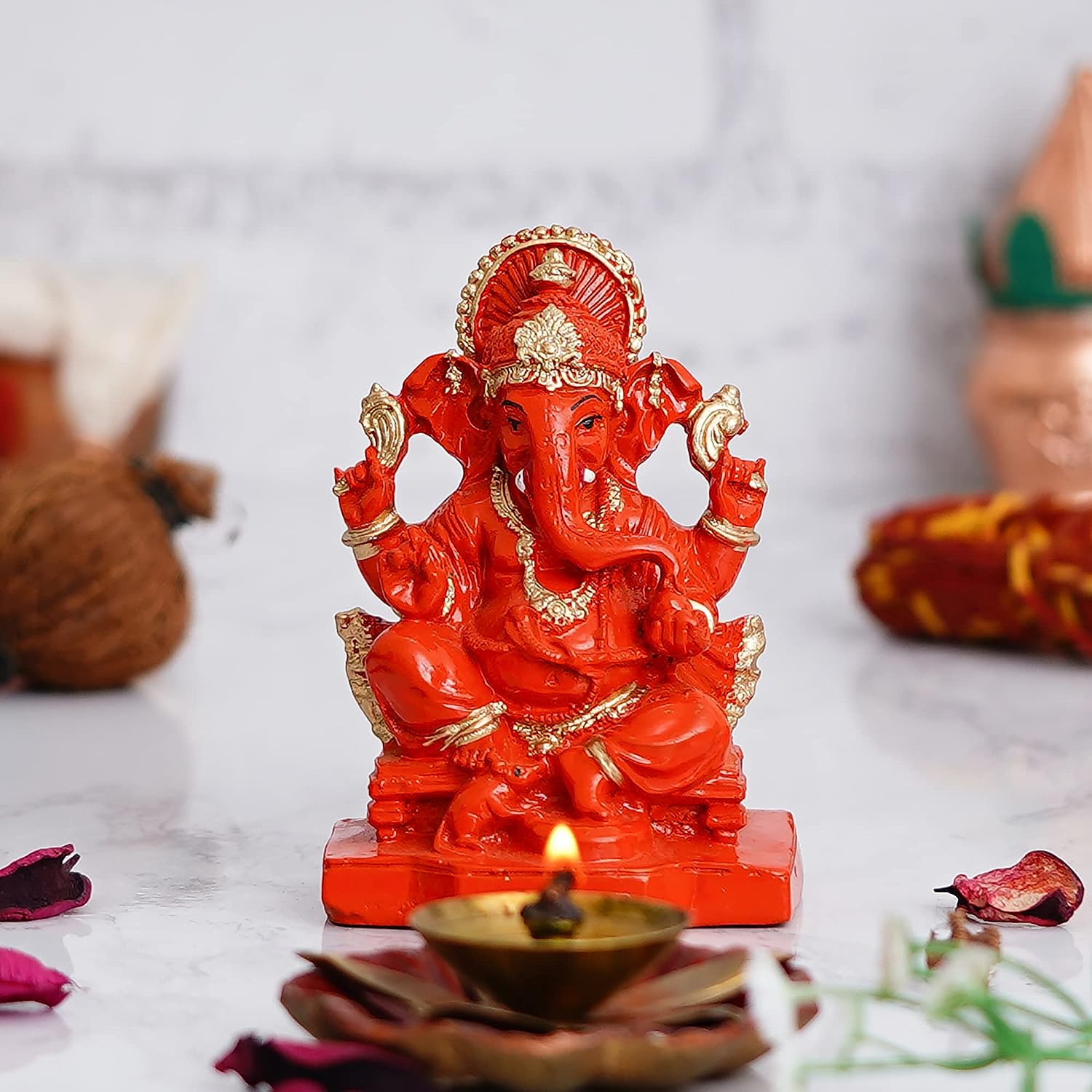There are a rare few people who do not adore Ganesha, the pot-bellied, elephant headed god, who loves to eat and enjoys music; as a matter of fact, it is said that all music in the world, every rhythm and musical note, actually flows through him! However, how many people know about the stories associated with this adorable god – how many people know why he has an elephant head or why his tusk is broken; read on to learn more!

The birth of Ganesha:
Goddess Parvati was getting ready for a bath and since she did not wish to be disturbed, she asked Nandi, Shiva’s bull to guard the door and not allow anyone inside. The loyal Nandi took up the post, but when Shiva arrived home, Nandi, who was more loyal to Shiva, allowed him inside, enraging Parvati. Angered by what happened, Parvati used the turmeric and sandalwood paste that she had applied on her body to create a boy. She breathed life into the statue and named the young boy, Ganesha.
The next time, she went for a bath, Parvati asked Ganesha to stand guard and when Shiva came home, he was not allowed inside. This time, it was Shiva’s turn to be furious and he ordered his army to destroy the boy. However, since Ganesha possessed the power of the Devi herself, Shiva’s army was not able to do much, pushing Shiva to take action himself. With one swish, Shiva cut Ganesha’s head off!
Parvati was furious when she heard of all this and swore to destroy all the worlds, which worried Lord Brahma, who was the creator of all the worlds. He begged Parvati to reconsider and she finally agreed on two conditions – one was that Ganesha be brought back to life and the second was that he would be prayed to before all gods.
By this time, Shiva’s anger had cooled down too and he was repentant of his actions, which is why he agreed to the terms placed forth by Parvati. Brahma was sent out to the find the first child that had its mother looking away, and an elephant was the first such animal that Brahma saw. The severed head of the elephant was brought back and placed on the body of the boy and as soon as Shiva breathed back life into the body, Ganesha, the elephant head god was alive again! Not only did Shiva accept him as his own son, he also gave him the status of being the first among all gods and the leaders of all the ganas, hence earning the name Ganpati.
How Ganesha lost one tusk:
Now, if you have looked closely at any Ganesha idols, you would have noticed that he is often missing a tusk or has a broken one – he is also referred to as Ekdantaya because of this. But did you how that happened – when sage Ved Vyasa decided to recite the Mahabharata, it was Ganesha who wrote it all down. However, Ved Vyasa did put one condition in front of Ganesha – once he started reciting, Ganesha could not stop writing and although he would be writing every word down, he would also have to understand each and every verse. Accepting the terms, Ganesha sat down to write and when the feather with which he was writing broke, he simply broke of his tusk and continued to write. It is said, that it took three years of Ved Vyas reciting and Ganesha writing to complete the entire Mahabharata.
Mooshak as friend and vehicle:
Every time you look at decorative door hangings that feature Ganesha, chances are that you will also see a little mouse somewhere around. There are several stories around Mooshak and here are some of the most popular ones:
- As per a story in Ganesha Purana, a gandharva names Krauncha was cursed by a sage and turned into a rat. This rat went on to serve Ganesha.
- Another Puranic legend talks about the demon Gajamukha being defeated by Ganesha in battle and being turned into a rat.
- In ancient times, agriculture was the predominant profession and rodents posed a big threat to crops. By making a rodent his vehicle, it is symbolic that Lord Ganesha conquered the pest form of the animal.
- Since Lord Ganesha needed to reach every corner of the universe to protect and help his subjects, a rat was the perfect vehicle as it could take him to any corner, nook and cranny!
- Did you know that Mooshak also got Ganesha and the moon into a little trouble? Once, when Ganesha and Mooshak were returning from a feast, Mooshak saw a snake and out of fear dropped Ganesha. When he fell, his stomach burst open and all the sweets, modaks and laddoos fell out. Ganesha quickly stuffed all the sweets back into his stomach and used the snake to tie it all up – watching all this, the moon burst out laughing. Ganesha was so angry that he broke off a tooth of his and threw it at the moon and cursed that it would never be able to shine again. The moon however, quickly understood his folly and apologised.
This is why Mooshak is also worshipped during Ganesh Chaturthi festival – the eleventh day of the celebrations are dedicated to the mouse friend and vehicle of Lord Ganesha.
The stories of Ganesh Chaturthi:
Although it is widely believed that Ganesh Chaturthi has been celebrated right from 271 BC to 1190 AD, when kingdoms including the Chalukya, Satavahana and Rashtrakuta were ruling the Indian subcontinent, the actual historical proof comes from the times of Chhatrapati Shivaji Maharaj. It is said that Ganesha was their kuladevata, and Shivaji Maharaj chose to celebrate the festival with great fervour, all across the Maratha empire. The Peshwas continued the trend, even after Shivaji was long gone and the same is followed even today!
In 1893, Bal Gangadhar Tilak, in order to rejuvenate the patriotic spirit of the people of India, pushed for Ganesh Chaturthi to be celebrated with great enthusiasm. In order to do that, he brought a private celebration, that was normally done at home with only the family, out onto the streets. When the British had imposed rules against large gatherings, Tilak asked people to come out onto the streets with idols of Ganesha and public celebrations. He made people make large Ganesha statues, bring out processions complete with colours, pooja thalis and sweets. The visarjan soon became a spectacle that took even the British aback and brought an immense amount of unity in the Indian people.
Celebrations for Ganesh Chaturthi:
Today, Ganesh Chaturthi is celebrated not only in Maharashtra, but also all over the country and in several other parts of the world, such as USA, UK, Thailand, Mauritius and Singapore. People bring home statues of Ganesha and worship him with love and immense reverence – special foods are made as offerings, mainly modak as that is considered to be Ganesha’s absolute favourite. And then, on the final day, with just as much love and celebration, he is taken to water bodies such as lakes, rivers or seas and immersed, with the wish that he will return the next year, bringing luck and prosperity.
This year, shop for Ganesha Pooja at eCraftIndia – whether you want to pick up a gorgeous Ganesha statue that will allow for an eco-friendly, at home visarjan or you want to look at stunning brass diyas online that will light up your home and pooja room, we have it all. We also have an exclusive range of wall decor and table décor items, which are Ganesha-centric – these are great for your home and also work wonders as gifts.
Top Quote for Father's Day
"Dads are most ordinary men turned by love into heroes, adventurers, storytellers, and singers of song." – Unknown

























